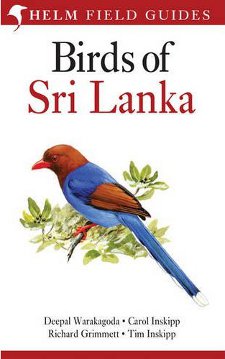Reviewed by Frank Lambert on April 10th, 2012.
Sri Lanka is a wonderful country to bird – being only about the size of West Virginia, most of the 30 or so endemic species and many of the distinctive endemic races can be seen in less than two weeks. Until now, however, there has not been a good quality, comprehensive country guide. Birds of Sri Lanka fills that niche nicely, and is well worth purchasing if you intend to visit the island. It is much more than a field guide, however, because it also contains an informative 19-page chapter on Birdwatching Areas. Altogether, 37 birding sites are covered in this chapter, which indicates which habitats occur at the site, suggests the best time to visit, and provides a list of birds likely to be seen.
The book is a spin-off of the 2nd (2012) edition of Birds of India: Pakistan, Nepal, Bangladesh, Bhutan, Sri Lanka, and the Maldives. The authors of that impressive field guide have teamed up with Deepal Warakagoda to prepare this Sri Lanka guide. Deepal is a well-known, knowledgeable Sri Lankan birder who, in 2004, discovered and described a new Sri Lankan endemic, the enigmatic Serendib Scops Owl Otus thilohoffmanni. His inclusion as an author has no doubt assisted greatly in ensuring that all relevant information on status and distribution is up to date.
Altogether, 237 resident species and 144 migrants and vagrants are covered in the main part of the book whilst an additional 72 (rarer) vagrants are given shorter species accounts and a single illustration in an Appendix. The species accounts, which face the relevant plate, focus on identification (including separation from similar species), status, voice, and habitat. The accompanying detailed distribution maps are colour-coded (differentiating between resident, winter visitor, etc.). These maps show the hills and mountains as shaded areas, so it is possible to see at a glance which species are confined to the lowlands and which prefer higher altitudes.
The book also has much useful information in the introduction, including sections about the geographic setting and climate, bird distribution and habitat types, and a summary of the threats to birds and their conservation in the region. Another section provides summaries of the various bird families covered by the guide: these will greatly benefit newcomers to the region. There is also a glossary with explanations of terminology used in describing birds, and a colour map of the island that shows the distribution of the distinctive arid, dry, and wet zones of the country.
Rasmussen included 33 Sri Lankan endemic species in Birds of South Asia: The Ripley Guide (Rasmussen and Anderton 2005 – Lynx Editions), but not all of the splits that she proposed have been adopted here. Hence this book treats only 27 species as endemic. Nevertheless, all potential splits have their own full species account, complete with text, map, and illustrations. For example, the distinctive Sri Lanka Drongo Dicrurus (paradiseus) lophorhinus, which occurs in the wet zone, though treated here as conspecific with Greater Raquet-tailed Drongo D. paridiseus (a dry zone bird in Sri Lanka), has a full species account alongside that of D. paridiseus. Another example is that of Crimson-backed Goldenback Chrysocolaptes (lucidus) stricklandi which is treated as conspecific with Greater Goldenback in this book. Nigel Collar (2011) recently reviewed woodpeckers of the Greater Goldenback complex and concluded that stricklandi does indeed warrant treatment as a full, endemic species, which IOC has adopted as Crimson-backed Flameback. We can expect that a number of the potential splits covered in this guide will be elevated to full species within the next few years – indeed IOC has already adopted a few that are treated as races in Birds of Sri Lanka, such as Sri Lanka Green Pigeon Treron pompadora and Sri Lanka Hill Myna Gracula ptilogenys. So the number of endemic species in Sri Lanka is likely to climb somewhat, and could perhaps reach as many as 35-40.
The artwork is generally of a very high standard and, where appropriate, distinctive plumages and races are shown. The races illustrated are of course those that occur in Sri Lanka rather than elsewhere in the Indian Subcontinent. For species often seen and identifiable in flight, such as larger waterbirds, shorebirds, raptors, and seabirds, there are good flight illustrations.
Birds of Sri Lanka is an excellent piece of work and a true field guide, fitting neatly into a large pocket or small bag. In conclusion then, this is the crucial guide for anyone intent on birding on the beautiful island of Sri Lanka.
– Reviewed by Frank Lambert
References
- Collar, N.J. (2011). Species limits in some Philippine birds including the Greater Flameback Chrysocolaptes lucidus. Forktail 27: 29–38.
Disclosure: I get a small commission for purchases made through links in this post.




 (4 votes, average: 3.50 out of 5)
(4 votes, average: 3.50 out of 5)
Comment